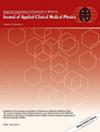Response prediction of radiotherapy in lung cancer patients using multimodal data
Abstract
Background and Purpose
Radiotherapy (RT) is a critical treatment for lung cancer; however, individual responses vary significantly. Pre-treatment prediction of RT response could guide clinical decision-making and identify patients unlikely to benefit. This study aims to predict RT response in lung cancer patients using multimodal data.
Methods
Patients diagnosed with lung cancer and scheduled to undergo RT at a single institution between May 2022 and October 2024 were selected. Multimodal data, encompassing demographic, radiological, biological, and physiological characteristics, were collected 1 week before RT initiation. Treatment plans followed the International Commission on Radiation Units and Measurements (ICRU) Report 83 guidelines, developed using a commercial treatment planning system and delivered via a linear accelerator with 6 MV photon beams. Radiological and biological data were reassessed 4 weeks after completion of RT, with treatment response classified according to Response Evaluation Criteria in Solid Tumors (RECIST). The dataset was split into training (70%), validation (15%), and testing (15%) sets using a stratified random sampling approach. A back propagation neural network (BPNN) was trained on the training set, and model performance was validated on the testing set.
Results
A total of 120 patients were analyzed. Of these, 41 were classified as having partial response (PR), 69 as stable disease (SD), and 10 as progressive disease (PD). Significant differences were observed among the groups in 58 characteristics, including 2 demographic, 5 radiological, 1 biological, and 50 physiological. Among the 34 features analyzed for PR prediction, the maximum vertical tumor diameter achieved an AUC of 0.699 (95% CI: 0.630–0.757). In contrast, the comprehensive BPNN model incorporating all characteristics showed an AUC of 0.855 (95% CI: 0.843-0.875), with a prediction mean squared error (MSE) of 0.07. Similarly, among the 36 features analyzed for PD prediction, the zero-crossing ratio of surface electromyography signals achieved an AUC of 0.750 (95% CI: 0.648–0.841). The comprehensive model further increased AUC to 0.929 (95% CI: 0.900–0.960), with a prediction MSE of 0.01.
Conclusion
Pretreatment demographic, radiological, and physiological characteristics were associated with RT response in lung cancer patients. The developed BPNN models leveraging multimodal data effectively predicted PR and PD, to guide personalized treatment strategies and to identify patients unlikely to benefit from RT.


 求助内容:
求助内容: 应助结果提醒方式:
应助结果提醒方式:


